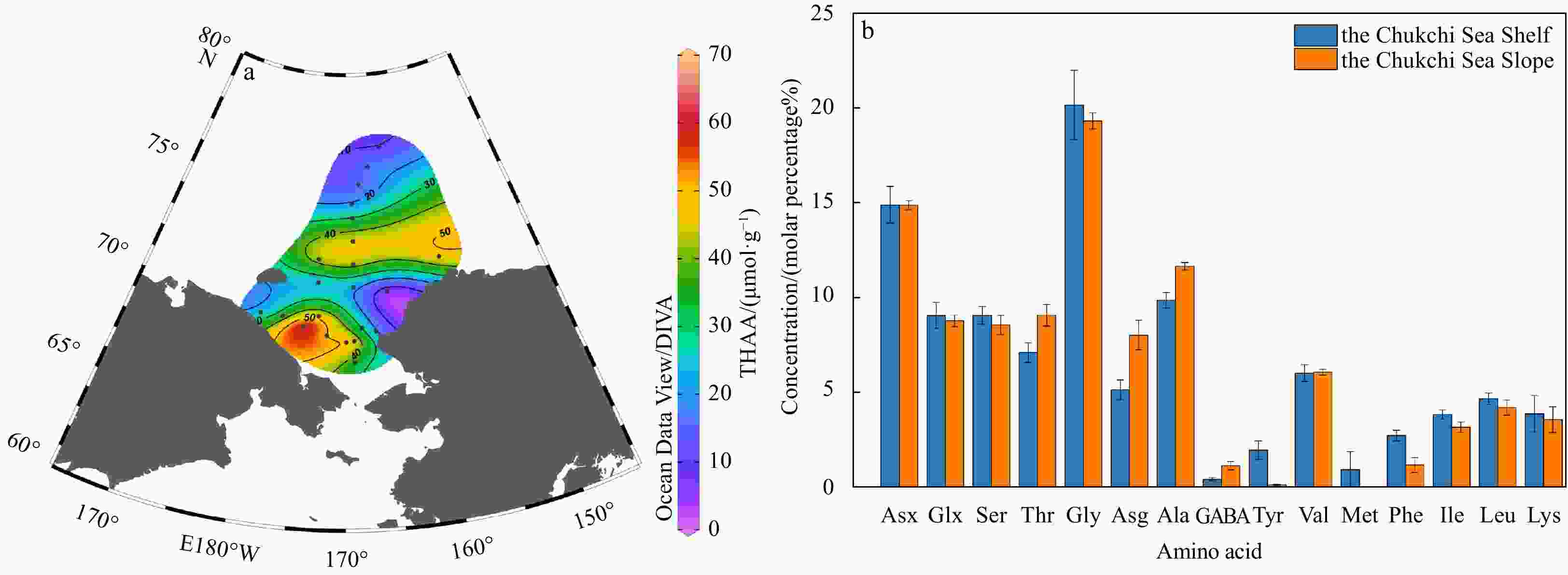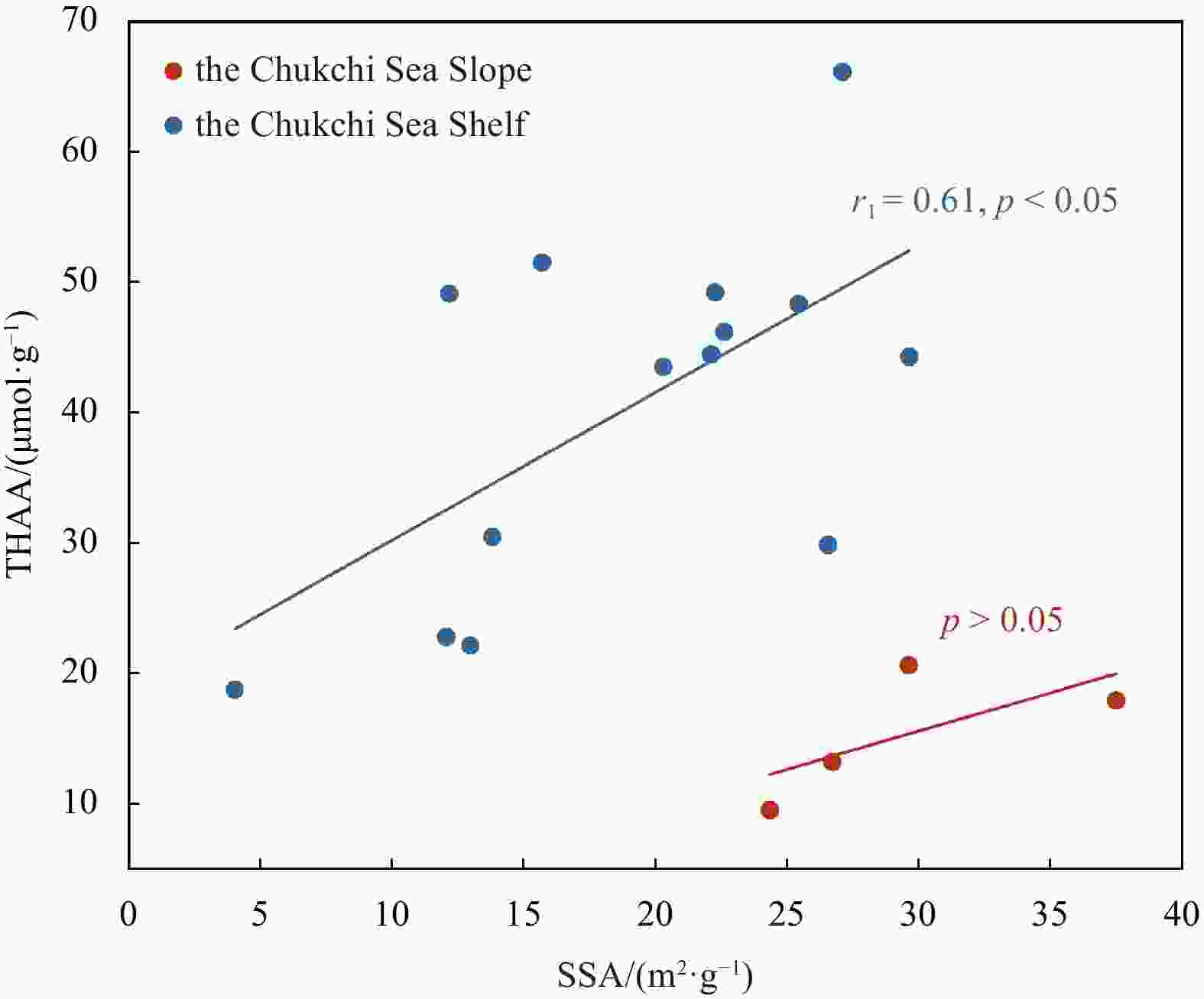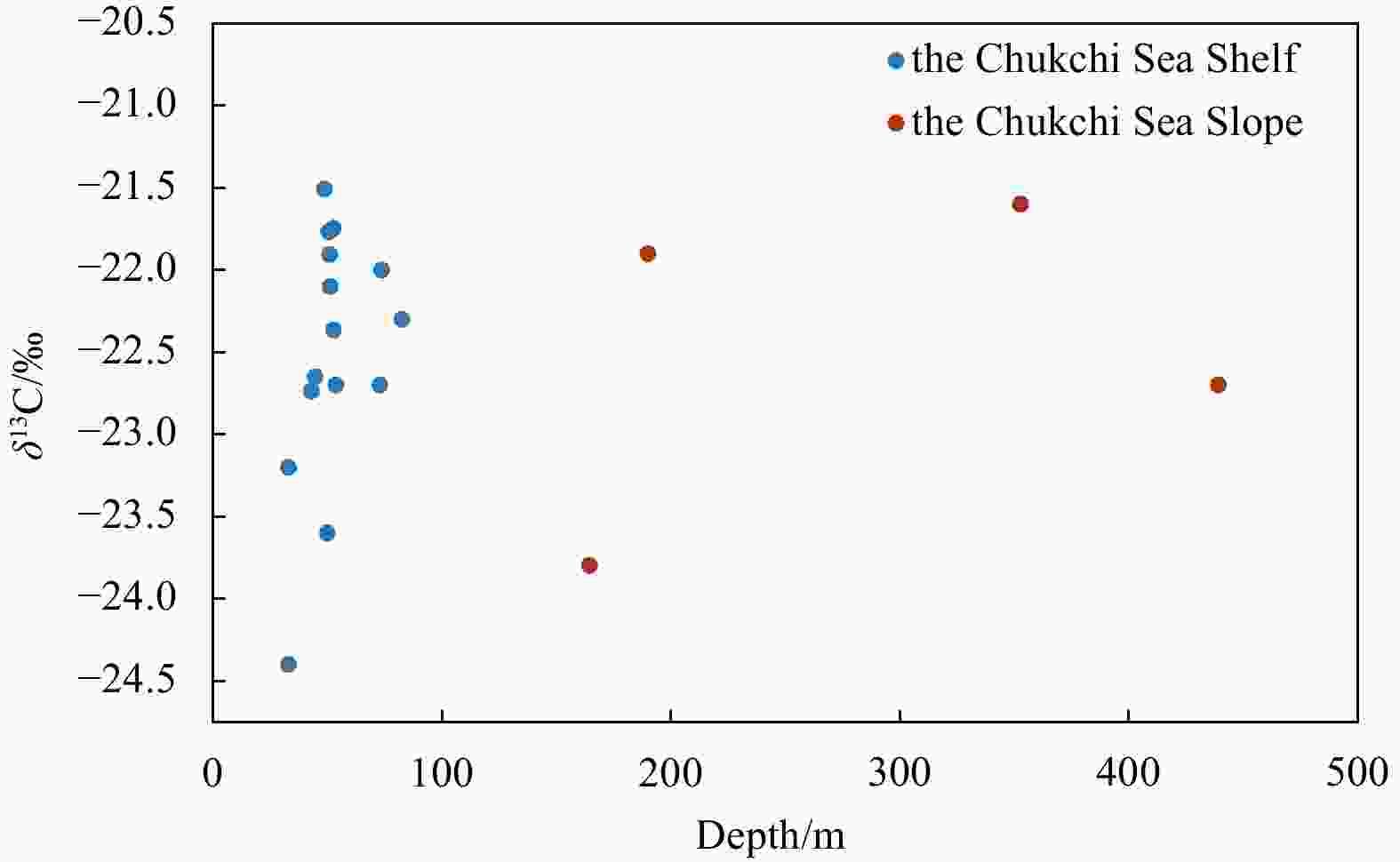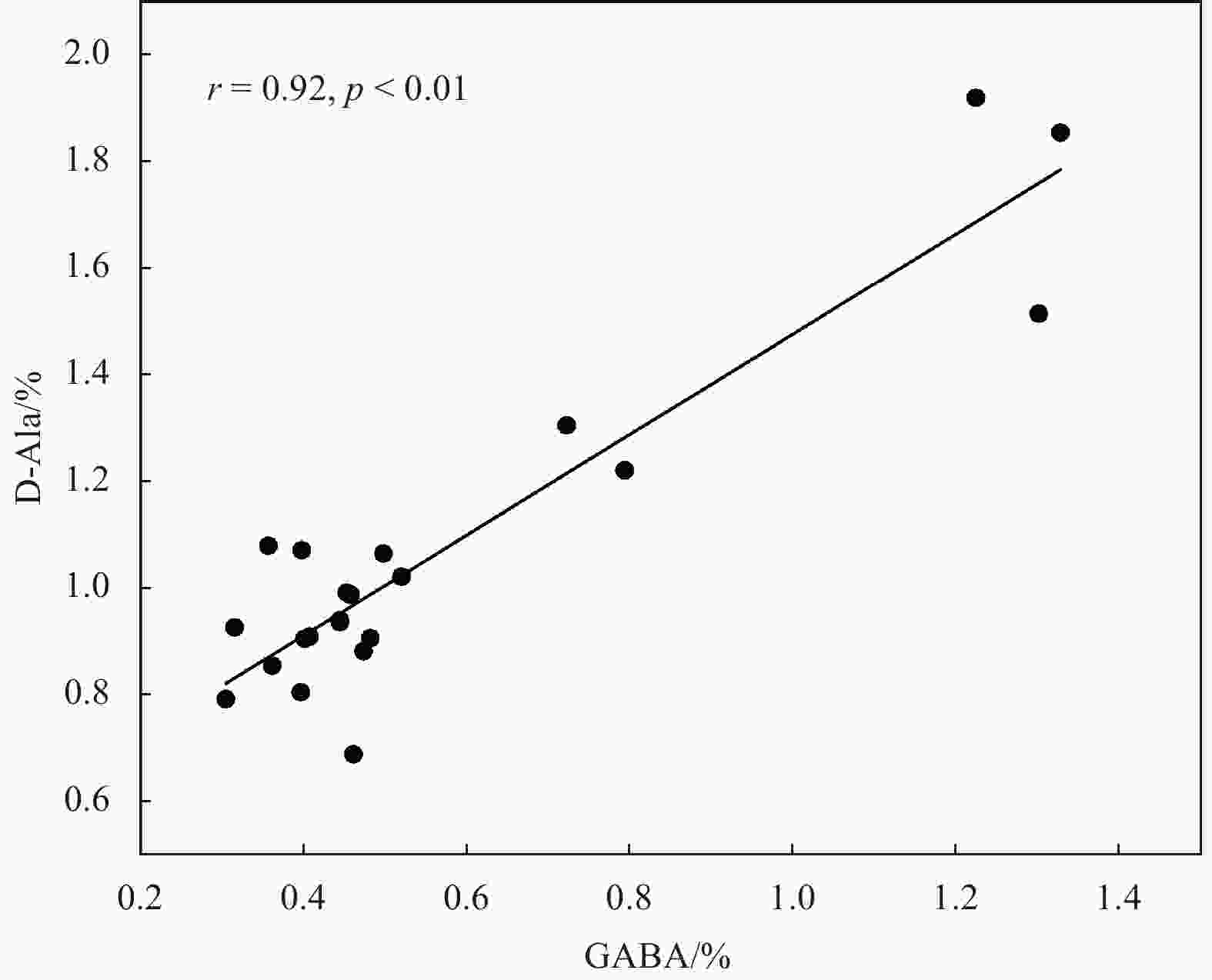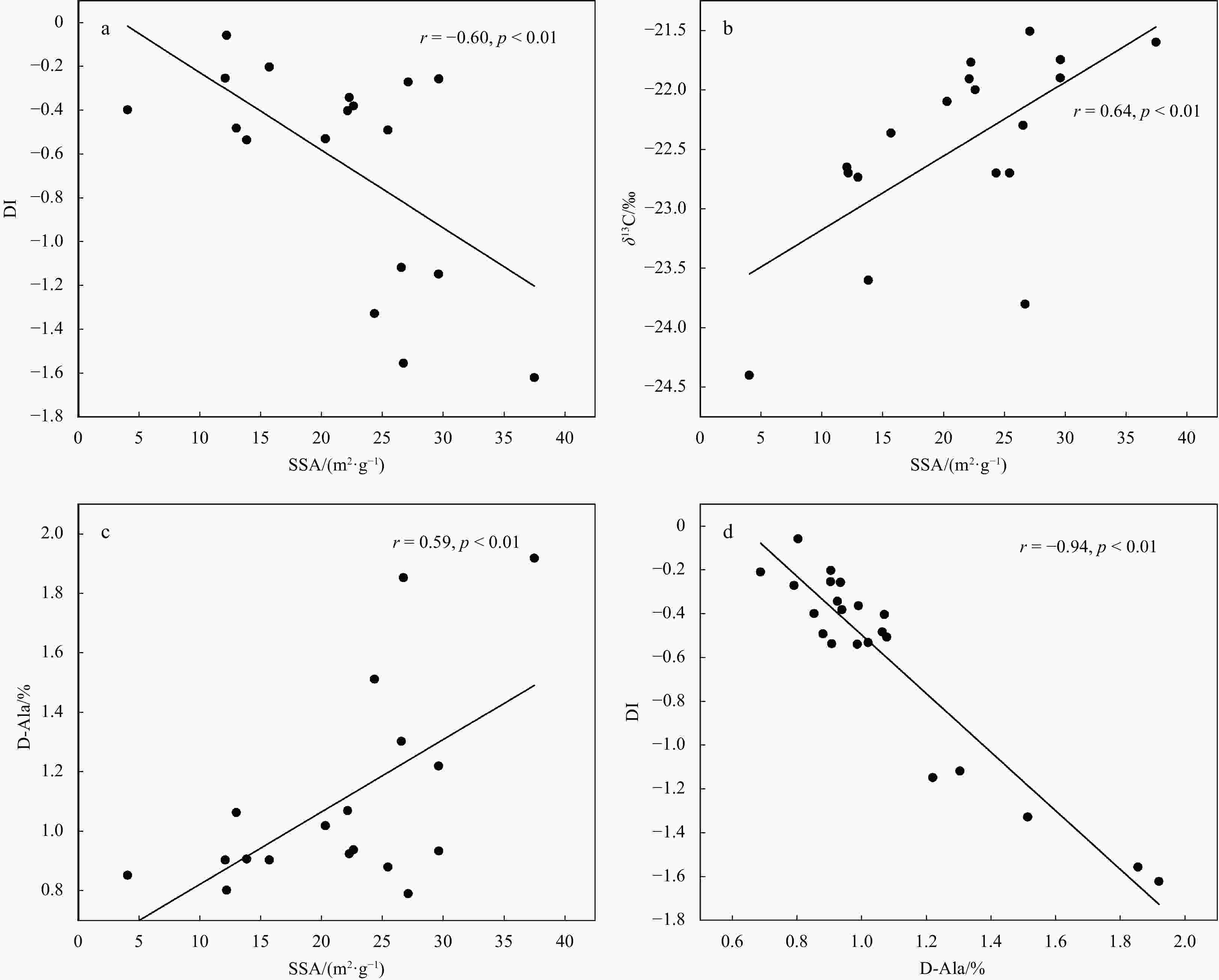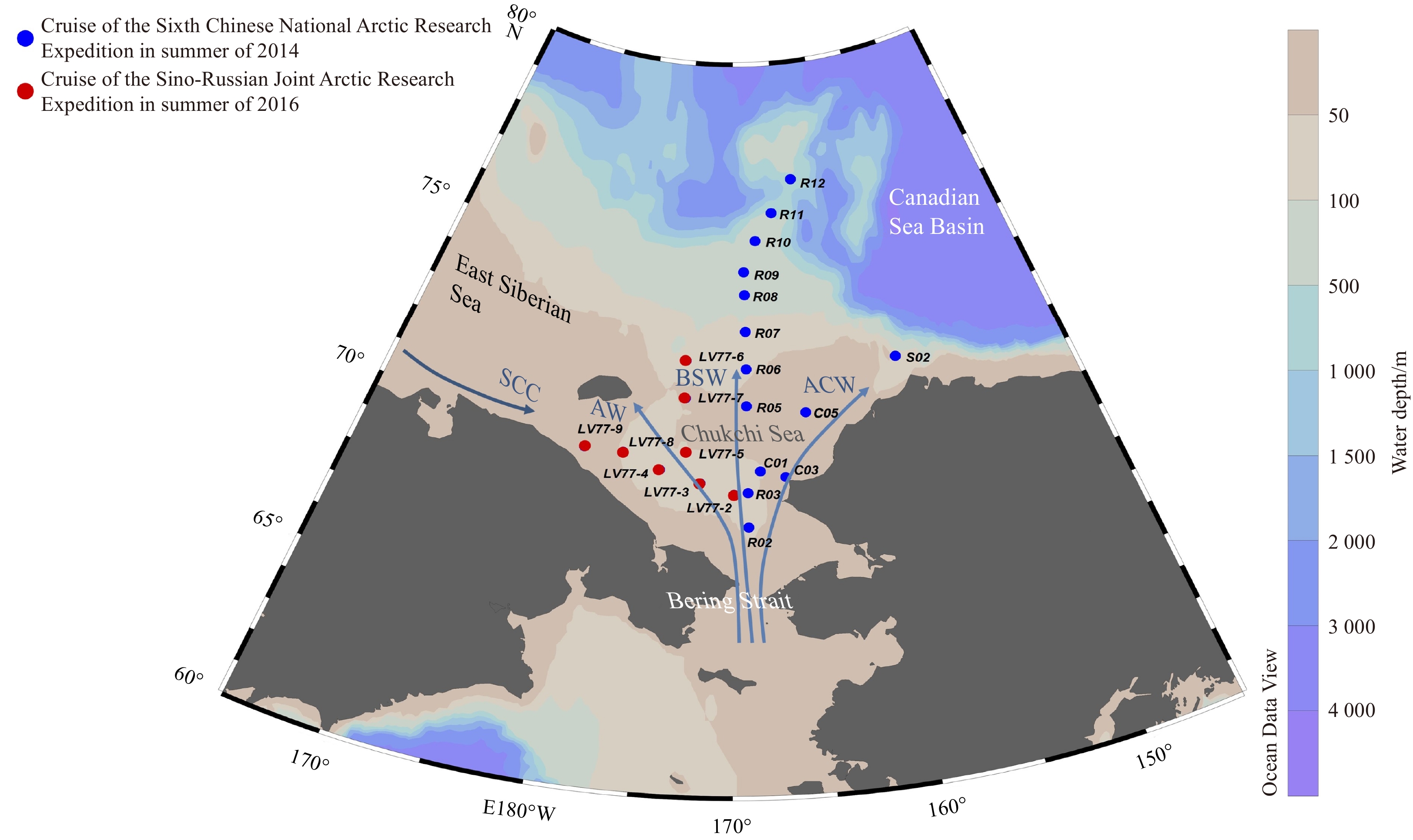Sources and degradation of organic matter in the surface sediments of the Chukchi Sea: insights from amino acids
-
Abstract: In the context of global warming and rapid environment change in the Arctic, the supply of organic matter (OM) has increased significantly and a large amount of OM are buried on the Arctic shelf. Studying the fate of OM in Arctic shelf sediments is crucial to understanding the global carbon sink. As a marginal sea of the Arctic Ocean, the Chukchi Sea is one of the most critical areas where OM is buried. Based on the surface sediment samples collected during the sixth Chinese National Arctic Research Expedition in the summer of 2014 and the Sino-Russian joint Arctic Research Expedition in the summer of 2016, this study takes amino acids (AAs) as the primary tool to explore the source and degradation of OM in the surface sediments of the Chukchi Sea. This study shows that total hydrolyzable amino acid (THAA) concentrations (dry weight) are high, with a mean value of (32.7 ± 15.8) μmol/g. Their spatial distribution is related to primary productivity, hydrodynamic conditions, sediment properties and other factors. The source of OM in the surface sediments of the Chukchi Sea is dominated by diatom-dominated marine productivity, with some input from terrestrial sources. Bacteria, as the main source of the D-enantiomer of AA (D-AA), not only have transforming effect on OM, but their cell walls and remnants likewise supply the OM pool. Based on a series of diagenetic indicators, we conclude that the OM in the surface sediments of the Chukchi Sea has undergone extensive degradation [DI (degradation index) = −0.59 ± 0.44], and the degradation degree in the slope is higher than that in the shelf. This study uses AA to explore the sources and degradation of OM in the sediments of the Chukchi Sea, which facilitates our understanding of OM transport and transformation on the Arctic shelf.
-
Key words:
- Chukchi Sea /
- amino acids /
- degradation indicator /
- organic matter
-
Table 1. Location, water depth, THAA content, OC content, specific surface area, carbon stable isotopes, THAA-C and DI of the Chukchi Sea surface sediments
Sample station Latitude/°N Longitude/°E Water depth/m THAA/(μmol·g−1) OC/% SSA/(m2·g−1) $ \text{δ} $13C/‰ THAA-C/% DI Shelf sediments LV77−2 68.57 190.09 52.70 51.5 1.68 15.68 −22.4 15.63 −0.20 LV77-3 68.88 187.85 51.00 44.4 2.03 22.11 −21.9 10.75 −0.40 LV77-4 69.20 185.09 48.70 66.1 2.64 27.08 −21.5 12.31 −0.27 LV77-5 69.71 186.79 50.60 49.2 1.93 22.25 −21.8 12.83 −0.34 LV77-6 72.20 186.38 52.72 44.2 2.08 29.61 −21.7 10.64 −0.26 LV77-7 71.18 186.51 43.00 22.1 0.98 12.97 −22.7 11.24 −0.48 LV77-8 69.59 182.52 47.00 32.2 1.00 − −22.2 15.97 −0.36 LV77-9 69.60 179.85 44.71 22.8 0.53 12.06 −22.7 21.45 −0.25 R02 67.67 −169.00 50.00 34.0 − − − − −0.51 R03 68.62 −169.00 53.70 49.1 1.11 12.17 −22.7 22.62 −0.06 R05 71.00 −169.00 44.00 23.0 − − − − −0.54 R06 72.00 −168.98 51.35 43.5 1.47 20.29 −22.1 14.68 −0.53 R07 73.00 −168.97 73.76 46.2 1.47 22.60 −22.0 15.68 −0.38 R08 74.00 −169.00 82.69 29.8 1.27 26.53 −22.3 11.42 −1.12 S02 71.92 −157.46 73.00 48.3 1.72 25.42 −22.7 14.14 −0.49 C01 69.22 −168.14 50.00 30.4 0.89 13.82 −23.6 16.99 −0.54 C03 69.03 −166.48 33.00 18.7 1.06 4.05 −24.4 8.83 −0.40 C05 70.76 −164.74 33.00 3.1 0.10 − −23.2 15.86 −0.21 Slope sediments R09 74.61 −169.03 190.00 20.6 0.86 29.59 −21.9 11.55 −1.15 R10 75.43 −167.90 164.36 13.2 0.56 26.70 −23.8 11.33 −1.55 R11 76.15 −166.20 352.43 18.0 0.79 37.45 −21.6 10.78 −1.62 R12 77.00 −163.89 438.86 9.6 0.50 24.32 −22.7 9.32 −1.33 Note: − represents no data. -
Alkhatib M, Schubert C J, del Giorgio P A, et al. 2012. Organic matter reactivity indicators in sediments of the St. Lawrence Estuary. Estuarine, Coastal and Shelf Science, 102–103: 36–47 Arrigo K R, van Dijken G L. 2011. Secular trends in Arctic Ocean net primary production. Journal of Geophysical Research: Oceans, 116(C9): C09011. doi: 10.1029/2011jc007151 Arrigo K R, van Dijken G, Pabi S. 2008. Impact of a shrinking Arctic ice cover on marine primary production. Geophysical Research Letters, 35(19): L19603. doi: 10.1029/2008GL035028 Bai Youcheng, Chen Jianfang, Li Hongliang, et al. 2010. The distribution of lipids biomarkers in the surface sediments of the Chukchi Sea and their implications. Haiyang Xuebao (in Chinese), 32(2): 106–117 Bao Rui, McIntyre C, Zhao Meixun, et al. 2016. Widespread dispersal and aging of organic carbon in shallow marginal seas. Geology, 44(10): 791–794. doi: 10.1130/G37948.1 Bates N R, Hansell D A, Moran S B, et al. 2005. Seasonal and spatial distribution of particulate organic matter (POM) in the Chukchi and Beaufort Seas. Deep-Sea Research Part II: Topical Studies in Oceanography, 52(24–26): 3324–3343. doi: 10.1016/j.dsr2.2005.10.003 Bourgoin L H, Tremblay L. 2010. Bacterial reworking of terrigenous and marine organic matter in estuarine water columns and sediments. Geochimica et Cosmochimica Acta, 74(19): 5593–5609. doi: 10.1016/j.gca.2010.06.037 Chen Yan, Hu Chun, Yang Guipeng, et al. 2021. Variation and reactivity of organic matter in the surface sediments of the Changjiang Estuary and its adjacent East China Sea. Journal of Geophysical Research: Biogeosciences, 126(1): e2020JG005765. doi: 10.1029/2020JG005765 Chen Jianfang, Jin Haiyan, Li Hongliang, et al. 2015. Carbon sink mechanism and processes in the Arctic Ocean under Arctic rapid change. Chinese Science Bulletin (in Chinese), 60(35): 3406–3416. doi: 10.1360/N972014-00397 Chen Yan, Yang Guipeng, Ji Chongxiao, et al. 2018. Sources and degradation of sedimentary organic matter in the mud belt of the East China Sea: implications from the enantiomers of amino acids. Organic Geochemistry, 116: 51–61. doi: 10.1016/j.orggeochem.2017.11.011 Coachman L K, Aagaard K, Tripp R B. 1975. Bering Strait: the Regional Physical Oceanography. Seattle: University of Washington Press, 158–162 Cooper L W, Grebmeier J M. 2018. Deposition patterns on the Chukchi shelf using radionuclide inventories in relation to surface sediment characteristics. Deep-Sea Research Part II: Topical Studies in Oceanography, 152: 48–66. doi: 10.1016/j.dsr2.2018.01.009 Cota G F, Pomeroy L R, Harrison W G, et al. 1996. Nutrients, primary production and microbial heterotrophy in the southeastern Chukchi Sea: Arctic summer nutrient depletion and heterotrophy. Marine Ecology Progress Series, 135: 247–258. doi: 10.3354/meps135247 Cowie G L, Hedges J I. 1992. Sources and reactivities of amino acids in a coastal marine environment. Limnology and Oceanography, 37(4): 703–724. doi: 10.4319/lo.1992.37.4.0703 Dauwe B, Middelburg J J. 1998. Amino acids and hexosamines as indicators of organic matter degradation state in North Sea sediments. Limnology and Oceanography, 43(5): 782–798. doi: 10.4319/lo.1998.43.5.0782 Dauwe B, Middelburg J J, Herman P M J, et al. 1999. Linking diagenetic alteration of amino acids and bulk organic matter reactivity. Limnology and Oceanography, 44(7): 1809–1814. doi: 10.4319/lo.1999.44.7.1809 Davis J, Kaiser K, Benner R. 2009. Amino acid and amino sugar yields and compositions as indicators of dissolved organic matter diagenesis. Organic Geochemistry, 40(3): 343–352. doi: 10.1016/j.orggeochem.2008.12.003 Dittmar T, Fitznar H P, Kattner G. 2001. Origin and biogeochemical cycling of organic nitrogen in the eastern Arctic Ocean as evident from D- and L-amino acids. Geochimica et Cosmochimica Acta, 65(22): 4103–4114. doi: 10.1016/S0016-7037(01)00688-3 Eicken H, Gradinger R, Gaylord A, et al. 2005. Sediment transport by sea ice in the Chukchi and Beaufort Seas: increasing importance due to changing ice conditions?. Deep-Sea Research Part II:Topical Studies in Oceanography, 52(24–26): 3281–3302. doi: 10.1016/j.dsr2.2005.10.006 Fitznar H P, Lobbes J M, Kattner G. 1999. Determination of enantiomeric amino acids with high-performance liquid chromatography and pre-column derivatisation with O-phthaldialdehyde and N-isobutyrylcysteine in seawater and fossil samples (mollusks). Journal of Chromatography A, 832(1–2): 123–132. doi: 10.1016/S0021-9673(98)01000-0 Goñi M A, Yunker M B, Macdonald R W, et al. 2005. The supply and preservation of ancient and modern components of organic carbon in the Canadian Beaufort Shelf of the Arctic Ocean. Marine Chemistry, 93(1): 53–73. doi: 10.1016/j.marchem.2004.08.001 Grebmeier J M, Cooper L W, Feder H M, et al. 2006. Ecosystem dynamics of the Pacific-influenced northern Bering and Chukchi Seas in the Amerasian Arctic. Progress in Oceanography, 71(2-4): 331–361. doi: 10.1016/j.pocean.2006.10.001 Grebmeier J M, Frey K E, Cooper L W, et al. 2018. Trends in benthic macrofaunal populations, seasonal sea ice persistence, and bottom water temperatures in the Bering Strait region. Oceanography, 31(2): 136–151 Gutiérrez D, Gallardo V A, Mayor S, et al. 2000. Effects of dissolved oxygen and fresh organic matter on the bioturbation potential of macrofauna in sublittoral sediments off Central Chile during the 1997/1998 El Niño. Marine Ecology Progress Series, 202: 81–99. doi: 10.3354/meps202081 Hecky R E, Mopper K, Kilham P, et al. 1973. The amino acid and sugar composition of diatom cell-walls. Marine Biology, 19(4): 323–331. doi: 10.1007/BF00348902 Hill V, Cota G. 2005. Spatial patterns of primary production on the shelf, slope and basin of the Western Arctic in 2002. Deep-Sea Research Part II: Topical Studies in Oceanography, 52(24–26): 3344–3354. doi: 10.1016/j.dsr2.2005.10.001 Hu Limin, Shi Xuefa, Yu Zhigang, et al. 2012. Distribution of sedimentary organic matter in estuarine-inner shelf regions of the East China Sea: implications for hydrodynamic forces and anthropogenic impact. Marine Chemistry, 142–144: 29–40 Ingalls A E, Lee C, Wakeham S G, et al. 2003. The role of biominerals in the sinking flux and preservation of amino acids in the Southern Ocean along 170°W. Deep-Sea Research Part II: Topical Studies in Oceanography, 50(3–4): 713–738. doi: 10.1016/S0967-0645(02)00592-1 Ittekkot V, Degens E T, Honjo S. 1984. Seasonality in the fluxes of sugars, amino acids, and amino sugars to the deep ocean: Panama Basin. Deep-Sea Research Part A: Oceanographic Research Papers, 31(9): 1071–1083 Jones E P, Anderson L G, Swift J H. 1998. Distribution of Atlantic and Pacific waters in the upper Arctic Ocean: implications for circulation. Geophysical Research Letters, 25(6): 765–768. doi: 10.1029/98GL00464 Kaiser K, Benner R. 2005. Hydrolysis-induced racemization of amino acids. Limnology and Oceanography: Methods, 3(8): 318–325. doi: 10.4319/lom.2005.3.318 Kaiser K, Benner R. 2008. Major bacterial contribution to the ocean reservoir of detrital organic carbon and nitrogen. Limnology and Oceanography, 53(1): 99–112. doi: 10.4319/lo.2008.53.1.0099 Kawasaki N, Benner R. 2006. Bacterial release of dissolved organic matter during cell growth and decline: molecular origin and composition. Limnology and Oceanography, 51(5): 2170–2180. doi: 10.4319/lo.2006.51.5.2170 Kawasaki N, Sohrin R, Ogawa H, et al. 2011. Bacterial carbon content and the living and detrital bacterial contributions to suspended particulate organic carbon in the North Pacific Ocean. Aquatic Microbial Ecology, 62(2): 165–176. doi: 10.3354/ame01462 Kim J H, Gal J K, Jun S Y, et al. 2019. Reconstructing spring sea ice concentration in the Chukchi Sea over recent centuries: insights into the application of the PIP25 index. Environmental Research Letters, 14(12): 125004. doi: 10.1088/1748-9326/ab4b6e Lawrence D M, Slater A G, Tomas R A, et al. 2008. Accelerated Arctic land warming and permafrost degradation during rapid sea ice loss. Geophysical Research Letters, 35(11): L11506. doi: 10.1029/2008GL033985 Lee C, Cronin C. 1982. The vertical flux of particulate organic nitrogen in the sea: decomposition of amino acids in the Peru upwelling area and the equatorial Atlantic. Journal of Marine Research, 40(1): 227–251 Lee C, Wakeham S G, Hedges J I. 2000. Composition and flux of particulate amino acids and chloropigments in equatorial Pacific seawater and sediments. Deep-Sea Research Part I: Oceanographic Research Papers, 47(8): 1535–1568. doi: 10.1016/S0967-0637(99)00116-8 Lepore K, Moran S B, Grebmeier J M, et al. 2007. Seasonal and interannual changes in particulate organic carbon export and deposition in the Chukchi Sea. Journal of Geophysical Research: Oceans, 112(C10): C10024. doi: 10.1029/2006JC003555 Li Ke, Jin Haiyan, Zhao Xiang’ai, et al. 2020. Sources and degradation of organic matter in the Bering Sea and the western Arctic Ocean: implication from fatty acids. Haiyang Xuebao (in Chinese), 42(10): 14–27 Li Zhongqiao, Wang Xinyi, Jin Haiyan, et al. 2017. Variations in organic carbon loading of surface sediments from the shelf to the slope of the Chukchi Sea, Arctic Ocean. Acta Oceanologica Sinica, 36(8): 131–136. doi: 10.1007/s13131-017-1026-y Lomstein B A, Jørgensen B B, Schubert C J, et al. 2006. Amino acid biogeo- and stereochemistry in coastal Chilean sediments. Geochimica et Cosmochimica Acta, 70(12): 2970–2989. doi: 10.1016/j.gca.2006.03.015 Macdonald R W, McLaughlin F A, Carmack E C. 2002. Fresh water and its sources during the SHEBA drift in the Canada Basin of the Arctic Ocean. Deep-Sea Research Part I: Oceanographic Research Papers, 49(10): 1769–1785. doi: 10.1016/S0967-0637(02)00097-3 Mathis J T, Bates N R, Hansell D A, et al. 2009. Net community production in the northeastern Chukchi Sea. Deep-Sea Research Part II: Topical Studies in Oceanography, 56(17): 1213–1222. doi: 10.1016/j.dsr2.2008.10.017 Mayer L M, Linda L S, Sawyer T, et al. 1995. Bioavailable amino acids in sediments: a biomimetic, kinetics based approach. Limnology and Oceanography, 40(3): 511–520. doi: 10.4319/lo.1995.40.3.0511 Meiners K, Krembs C, Gradinger R. 2008. Exopolymer particles: microbial hotspots of enhanced bacterial activity in Arctic fast ice (Chukchi Sea). Aquatic Microbial Ecology, 52(2): 195–207 Moran S B, Kelly R P, Hagstrom K, et al. 2005. Seasonal changes in POC export flux in the Chukchi Sea and implications for water column-benthic coupling in Arctic shelves. Deep-Sea Research Part II: Topical Studies in Oceanography, 52(24–26): 3427–3451. doi: 10.1016/j.dsr2.2005.09.011 Müller P J, Suess E, AndréUngerer C. 1986. Amino acids and amino sugars of surface particulate and sediment trap material from waters of the Scotia Sea. Deep-Sea Research Part A: Oceanographic Research Papers, 33(6): 819–838 Nagata T, Fukuda R, Koike I, et al. 1998. Degradation by bacteria of membrane and soluble protein in seawater. Aquatic Microbial Ecology, 14(1): 29–37 Overland J E, Wang Muyin, Walsh J E, et al. 2014. Future Arctic climate changes: adaptation and mitigation time scales. Earth's Future, 2(2): 68–74. doi: 10.1002/2013EF000162 Palmer M A, Saenz B T, Arrigo K R. 2014. Impacts of sea ice retreat, thinning, and melt-pond proliferation on the summer phytoplankton bloom in the Chukchi Sea, Arctic Ocean. Deep-Sea Research Part II: Topical Studies in Oceanography, 105: 85–104. doi: 10.1016/j.dsr2.2014.03.016 Qiu Zhongyan, Shen Zhongyue, Han Xiqiu. 2007. Clay minerals in surface sediments from Arctic Ocean and their environmental significance. Marine Geology & Quaternary Geology (in Chinese), 27(3): 31–36 Ren Jian, Chen Jianfang, Bai Youcheng, et al. 2020. Diatom composition and fluxes over the Northwind Ridge, western Arctic Ocean: impacts of marine surface circulation and sea ice distribution. Progress in Oceanography, 186: 102377. doi: 10.1016/j.pocean.2020.102377 Sakamoto T, Ikehara M, Aoki K, et al. 2005. Ice-rafted debris (IRD)-based sea-ice expansion events during the past 100 kyrs in the Okhotsk Sea. Deep-Sea Research Part II: Topical Studies in Oceanography, 52(16–18): 2275–2301. doi: 10.1016/j.dsr2.2005.08.007 Schädel C. 2022. Arctic coasts predicted to erode. Nature Climate Change, 12(3): 224–225. doi: 10.1038/s41558-022-01286-9 Stein R, Fahl K. 2000. Holocene accumulation of organic carbon at the Laptev Sea continental margin (Arctic Ocean): sources, pathways, and sinks. Geo-Marine Letters, 20(1): 27–36. doi: 10.1007/s003670000028 Stein R, MacDonald R. 2004. The Organic Carbon Cycle in the Arctic Ocean. Berlin: Springer, 315–322 Stroeve J C, Serreze M C, Fetterer F, et al. 2005. Tracking the Arctic's shrinking ice cover: another extreme September minimum in 2004. Geophysical Research Letters, 32(4): L04501. doi: 10.1029/2004GL021810 Su Liang, Ren Jian, Sicre M A, et al. 2022. HBIs and sterols in surface sediments across the East Siberian Sea: implications for palaeo sea-ice reconstructions. Geochemistry, Geophysics, Geosystems, 23(2): e2021GC009940 Suthhof A, Jennerjahn T C, Schäfer P, et al. 2000. Nature of organic matter in surface sediments from the Pakistan continental margin and the deep Arabian Sea: amino acids. Deep-Sea Research Part II: Topical Studies in Oceanography, 47(1–2): 329–351. doi: 10.1016/S0967-0645(99)00109-5 Terhaar J, Lauerwald R, Regnier P, et al. 2021. Around one third of current Arctic Ocean primary production sustained by rivers and coastal erosion. Nature Communications, 12(1): 169. doi: 10.1038/s41467-020-20470-z Tesi T, Semiletov I, Hugelius G, et al. 2014. Composition and fate of terrigenous organic matter along the Arctic land–ocean continuum in East Siberia: insights from biomarkers and carbon isotopes. Geochimica et Cosmochimica Acta, 133: 235–256. doi: 10.1016/j.gca.2014.02.045 Tremblay L, Benner R. 2009. Organic matter diagenesis and bacterial contributions to detrital carbon and nitrogen in the Amazon River system. Limnology and Oceanography, 54(3): 681–691. doi: 10.4319/lo.2009.54.3.0681 Vandewiele S, Cowie G, Soetaert K, et al. 2009. Amino acid biogeochemistry and organic matter degradation state across the Pakistan margin oxygen minimum zone. Deep-Sea Research Part II: Topical Studies in Oceanography, 56(6–7): 376–392. doi: 10.1016/j.dsr2.2008.05.035 Venturini N, Pires-Vanin A M S, Salhi M, et al. 2011. Polychaete response to fresh food supply at organically enriched coastal sites: repercussion on bioturbation potential and trophic structure. Journal of Marine Systems, 88(4): 526–541. doi: 10.1016/j.jmarsys.2011.07.002 Walsh J J, McRoy C P, Coachman L K, et al. 1989. Carbon and nitrogen cycling within the Bering/Chukchi Seas: source regions for organic matter effecting AOU demands of the Arctic Ocean. Progress in Oceanography, 22(4): 277–359. doi: 10.1016/0079-6611(89)90006-2 Wang Kui, Chen Jianfang, Jin Haiyan, et al. 2008. Amino acids in surface sediment of chukchi sea-Canada Basin. Acta Sedimentologica Sinica (in Chinese), 26(4): 661–669 Wang Kui, Chen Jianfang, Jin Haiyan, et al. 2018. Organic matter degradation in surface sediments of the Changjiang estuary: evidence from amino acids. Science of the Total Environment, 637–638: 1004–1013 Wang Xinyi, Li Zhongqiao, Jin Haiyan, et al. 2017. Sources and degradation of organic carbon in the surface sediments across the Chukchi Sea, insights from lignin phenols. Haiyang Xuebao (in Chinese), 39(10): 19–31 Woodgate R A. 2018. Increases in the Pacific inflow to the Arctic from 1990 to 2015, and insights into seasonal trends and driving mechanisms from year-round Bering Strait mooring data. Progress in Oceanography, 160: 124–154. doi: 10.1016/j.pocean.2017.12.007 Woodgate R A, Aagaard K, Swift J H, et al. 2005. Pacific ventilation of the Arctic Ocean’s lower halocline by upwelling and diapycnal mixing over the continental margin. Geophysical Research Letters, 32(18): L18609. doi: 10.1029/2005GL023999 Wu Ying, Dittmar T, Ludwichowski K U, et al. 2007. Tracing suspended organic nitrogen from the Yangtze River catchment into the East China Sea. Marine Chemistry, 107(3): 367–377. doi: 10.1016/j.marchem.2007.01.022 Xu Fanglu, Jin Haiyan, Ji Zhongqiang, et al. 2017. Sources and distribution of sedimentary organic matter along the northern Bering and Chukchi Seas. Journal of Environmental Sciences, 52: 66–75. doi: 10.1016/j.jes.2016.04.003 Ye Jun, Hu Limin, Shi Xuefa, et al. 2021. Sources, transport and burial of terrestrial organic carbon in the surface sediments across the East Siberian Arctic shelf, insights from lignin. Quaternary Sciences (in Chinese), 41(3): 752–765 Yu Wen, He Jianhua, Li Yuhong, et al. 2012. Particulate organic carbon export fluxes and validation of steady state model of 234Th export in the Chukchi Sea. Deep-Sea Research Part II: Topical Studies in Oceanography, 81–84: 63–71 Zhang Yang, Ji Zhongqiang, Zhuang Yanpei, et al. 2015. The implication of chlorin to marine-derived organic matter in northwest Arctic Ocean. Bulletin of Mineralogy, Petrology and Geochemistry (in Chinese), 34(6): 1123−1130 Zhang J, Zhang R, Wu Q, et al. 2012. Diagenetic alterations of amino acids and organic matter in the upper Pearl River Estuary surface sediments. Biogeosciences, 9(1): 555–564. doi: 10.5194/bg-9-555-2012 Zhang Zilian, Zheng Qiang, Jiao Nianzhi. 2016. Microbial D-amino acids and marine carbon storage. Science China: Earth Sciences, 59(1): 17–24. doi: 10.1007/s11430-015-5155-x Zhu Zhuoyi, Wu Ying, Liu Sumei, et al. 2016. Organic carbon flux and particulate organic matter composition in Arctic valley glaciers: examples from the Bayelva River and adjacent Kongsfjorden. Biogeosciences, 13(4): 975–987. doi: 10.5194/bg-13-975-2016 Zhuang Yanpei, Jin Haiyan, Chen Jianfang, et al. 2020. Phytoplankton community structure at subsurface chlorophyll maxima on the western Arctic shelf: patterns, causes, and ecological importance. Journal of Geophysical Research: Biogeosciences, 125(6): e2019JG005570. doi: 10.1029/2019JG005570 Zhuang Yanpei, Jin Haiyan, Li Hongliang, et al. 2016. Pacific inflow control on phytoplankton community in the Eastern Chukchi Shelf during summer. Continental Shelf Research, 129: 23–32. doi: 10.1016/j.csr.2016.09.010 Zonneveld K A F, Versteegh G J M, Kasten S, et al. 2010. Selective preservation of organic matter in marine environments; processes and impact on the sedimentary record. Biogeosciences, 7(2): 483–511. doi: 10.5194/bg-7-483-2010 -




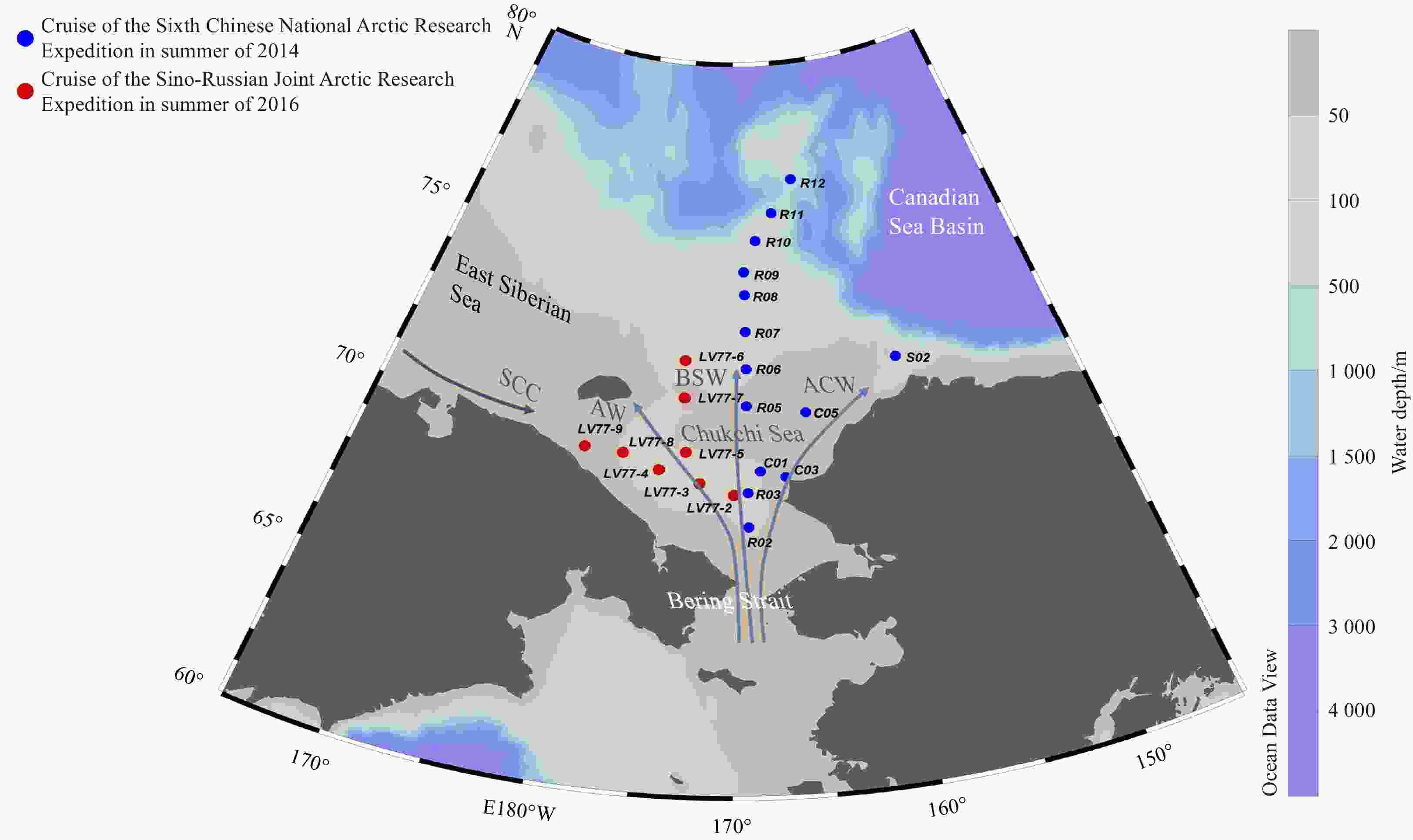
 下载:
下载:
